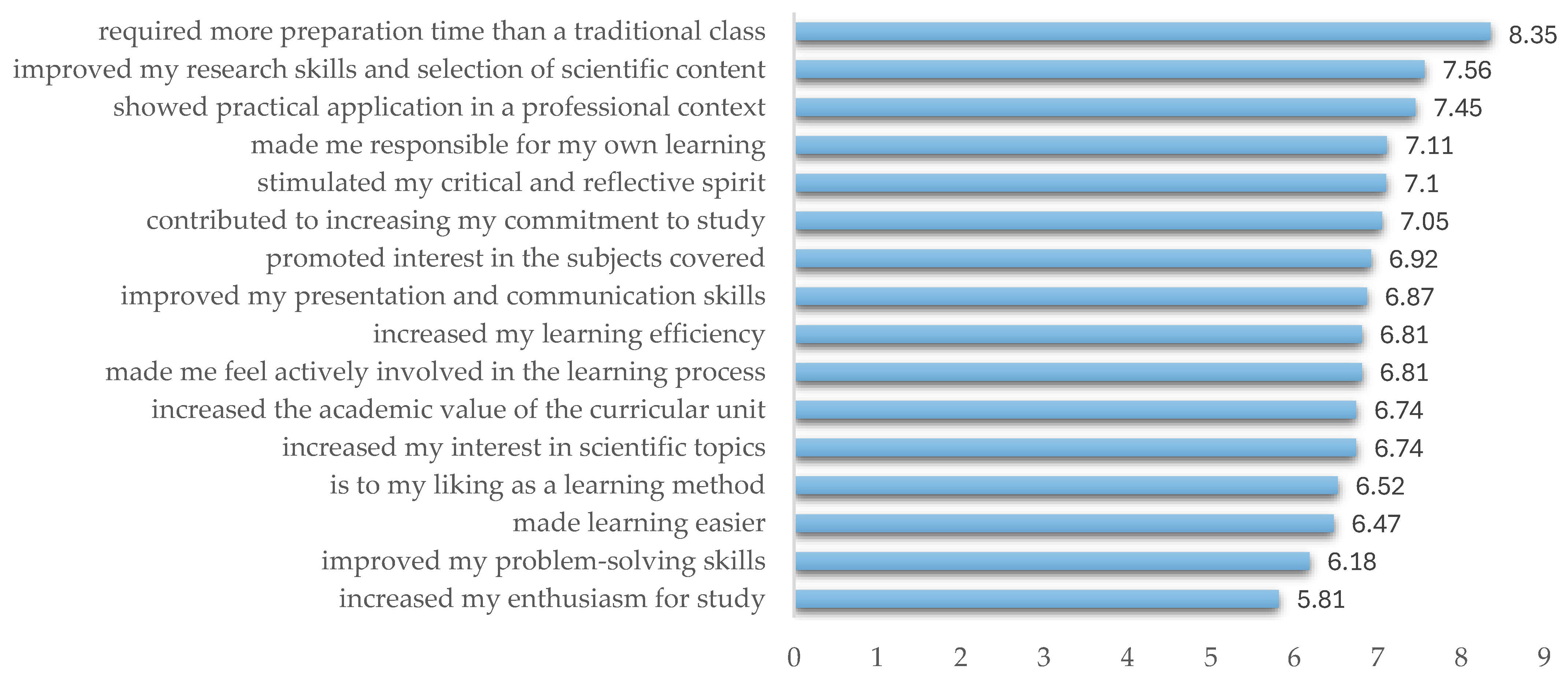Rethinking Science Teaching for the 21st Century: A SWOT Analysis of a Multi-Strategic Model †
7th CiiEM International Congress 2025—Empowering One Health to Reduce Social Vulnerabilities
)
Abstract
1. Introduction
2. Materials and Methods
2.1. Pre-Class
2.2. In-Class
2.3. Post-Class
3. Results and Discussion
4. Conclusions
Author Contributions
Funding
Institutional Review Board Statement
Informed Consent Statement
Data Availability Statement
Acknowledgments
Conflicts of Interest
References
- Biggs, J.; Tang, C.; Kennedy, G. Teaching for Quality Learning at University, 5th ed.; Open University Press—McGraw Hill: Buckingham, UK, 2022; ISBN 9780335250820. [Google Scholar]
- Prince, M. Does active learning work? A review of the research. J. Eng. Educ. 2004, 93, 223–231. [Google Scholar] [CrossRef]
- Bergmann, J.; Sams, A. Flip Your Classroom: Reach Every Student in Every Class Every Day; International Society for Technology in Education: Eugene, OR, USA, 2023; ISBN 9781564849861. [Google Scholar]
- Nicol, D.J.; Macfarlane-Dick, D. Formative assessment and self-regulated learning: A model and seven principles of good feedback practice. Stud. High. Educ. 2006, 31, 199–218. [Google Scholar] [CrossRef]
- Freeman, S.; Eddy, S.L.; McDonough, M.; Smith, M.K.; Okoroafor, N.; Jordt, H.; Wenderoth, M.P. Active learning increases student performance in science, engineering, and mathematics. Proc. Natl. Acad. Sci. USA 2014, 111, 8410–8415. [Google Scholar] [CrossRef] [PubMed]
- OECD. The Future of Education and Skills: Education 2030; OECD Publishing, Ed.; Organisation for Economic Co-Operation and Development: Paris, France, 2018. [Google Scholar]
- Cavaco-Silva, P.; Ribeiro, A.C.; Figueiredo, A.; Guerreiro, D.; Oliveira-Torres, E.; Costa, I.M.; Couvaneiro, J.; Aguiar, J.P.; Inez, R.; Branco, V.; et al. Objective Structured Clinical/Practical Examination (OSC/PE) in Pharmaceutical Sciences Education—A Pilot Study; Ramos, F., Ed.; Ordem dos Farmacêuticos, SRP: Porto, Portugal, 2023. [Google Scholar]

| Strengths (S) | Weaknesses (W) |
|---|---|
| [S] Felt more actively involved in learning (6.81) and more responsible for their learning (7.11); | [S] Found the method demanding in terms of time (8.35), with moderate enjoyment (6.52) and enthusiasm (5.81); [S] Moderately improved problem-solving skills (6.52) and learning ease (6.47). [P] Limited time in class for deep exploration and individual feedback; [P] Some students miss post-class tasks, leading to incomplete learning cycles; [P] Difficulties managing large groups and tracking peer evaluations on Moodle; [P] Students with poor English or lack of autonomy struggle to follow class structure; [P] Rigid schedules and physical classroom limitations hinder collaboration and responsiveness; [P] Lack of consistent post-class engagement and challenges to use OSCPE as a learning strategy due to late application (end of semester). |
| [S] Reported gains in research (7.56), presentation and communication (6.87) skills; [S] Perceived practical relevance of the model (7.45); [S] Stated promoted learning efficiency (6.81) and interest in the subject (6.92); [S] IMTS stimulates critical thinking (7.10), interest in scientific topics (6.74), and commitment (7.05). [P] Lessons are dynamic and diversified due to the varied teaching–learning methodologies and subjects; [P] Peer evaluation gives [S] a clearer understanding of their own performance, highlights areas of improvement; [P] Increase in transversal competencies (e.g., stress management, teamwork, communication in various contexts); [P] Unique group projects enrich overall learning/discussion; [P] IMTS fosters curricular integration and real-life simulation through final OSCPE exam. | |
| Opportunities (O) | Threats (T) |
| [P] Good Pedagogical Practice (awarded in 2024) offers institutional credibility and dissemination potential; [P] Encourage AI use for problem-solving, real-world task alignment and work opportunities; [P] Use high-impact elements (research, relevance) as drivers of engagement; [P] Adaptable to various curricula; transferable across disciplines. [SP] Feedback-driven improvements and flexible evaluation models to promote continuous refinement. | [P] High workload perception may reduce engagement or increase stress; [P] Risk of inequity if autonomy levels overwhelm less prepared students; [P] Unsuitable for students resistant to active learning or lacking self-discipline; [P] Non-native [S] may disengage due to language barriers; [P] Student absences and disengagement negatively affect group dynamics and outcomes; [P] Overreliance on AI without critical thinking can lead to unstructured or superficial learning; [P] Risk of professor burnout due to intense demands and limited support infrastructure; [P] Current peer-assessment tools (Moodle) lack transparency and efficiency for formative use. |
Disclaimer/Publisher’s Note: The statements, opinions and data contained in all publications are solely those of the individual author(s) and contributor(s) and not of MDPI and/or the editor(s). MDPI and/or the editor(s) disclaim responsibility for any injury to people or property resulting from any ideas, methods, instructions or products referred to in the content. |
© 2025 by the authors. Licensee MDPI, Basel, Switzerland. This article is an open access article distributed under the terms and conditions of the Creative Commons Attribution (CC BY) license (https://creativecommons.org/licenses/by/4.0/).
Share and Cite
Fernandes, A.I.; Miranda, M. Rethinking Science Teaching for the 21st Century: A SWOT Analysis of a Multi-Strategic Model. Med. Sci. Forum 2025, 37, 7. https://doi.org/10.3390/msf2025037007
Fernandes AI, Miranda M. Rethinking Science Teaching for the 21st Century: A SWOT Analysis of a Multi-Strategic Model. Medical Sciences Forum. 2025; 37(1):7. https://doi.org/10.3390/msf2025037007
Chicago/Turabian StyleFernandes, Ana Isabel, and Margarida Miranda. 2025. "Rethinking Science Teaching for the 21st Century: A SWOT Analysis of a Multi-Strategic Model" Medical Sciences Forum 37, no. 1: 7. https://doi.org/10.3390/msf2025037007
APA StyleFernandes, A. I., & Miranda, M. (2025). Rethinking Science Teaching for the 21st Century: A SWOT Analysis of a Multi-Strategic Model. Medical Sciences Forum, 37(1), 7. https://doi.org/10.3390/msf2025037007







